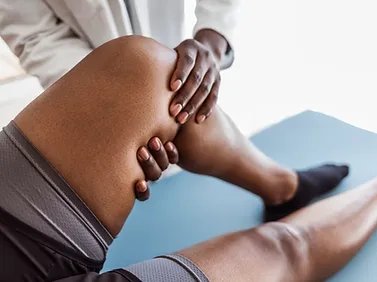Meniscus Injuries
Injury Guide

At Latitude Physiotherapy, we understand the challenges athletes face and are dedicated to helping you recover, rebuild, and return to peak performance. In this guide, we will explore the symptoms and causes of meniscus injuries and outline effective rehabilitation strategies tailored specifically for athletes.
Symptoms:
Meniscus injuries can cause a range of symptoms that athletes need to be aware of. Athletes experiencing a meniscus injury may present with persistent pain localized along the joint line, worsened during movements that stress the injured area. Swelling is also common, caused by the accumulation of fluid as a result of the injury. Additionally, athletes may experience limited range of motion in the knee joint and a locking or catching sensation during movement.
Anatomy:
Click and hold to rotate. Shift+click and hold to pan. Click+scroll to zoom.
The meniscus is a C-shaped cartilage structure located in the knee joint between the femur (thighbone) and tibia (shinbone). It serves as a shock absorber, distributing the forces exerted on the knee during movement and providing stability to the joint.
Each knee has two menisci: the medial meniscus on the inner side of the knee and the lateral meniscus on the outer side. The menisci have a delicate balance of firmness and flexibility, allowing them to absorb impact and provide cushioning while maintaining joint stability.
When a meniscus injury occurs, it can disrupt the integrity of the meniscus and compromise its essential functions. There are different types of meniscus injuries, including:
1. Acute Tears: These occur when the meniscus is subjected to excessive force or twisting motions that exceed its capacity. Meniscal tears can range from small partial tears to larger complete tears that extend through the entire meniscus. The location, size, and pattern of the tear can influence the severity of symptoms and treatment options.
2. Degenerative Tears: Over time, the meniscus may undergo degenerative changes, becoming more susceptible to tears, even with minimal trauma or stress. These tears are commonly seen in older athletes or individuals with pre-existing degenerative joint conditions.
The implications of meniscus injuries on athletes are significant. An injured meniscus can lead to pain, swelling, and limitations in knee function, affecting an athlete’s performance and overall quality of life. Meniscus injuries can also predispose athletes to other knee problems, such as osteoarthritis, if left untreated or if improper rehabilitation is undertaken.
Additionally, the location and extent of the meniscus injury can impact the treatment approach and prognosis. The outer edge of the meniscus, known as the “red zone,” has a better blood supply and thus a higher chance of healing naturally. In contrast, the inner edge, referred to as the “white zone,” has a limited blood supply, thus reestablishing full joint mobility is essential in rehab.
Causes:
Several factors can contribute to meniscus injuries in athletes. Sudden twisting or rotational forces, such as rapid changes in direction or landing awkwardly, can place excessive stress on the meniscus. Direct impacts to the knee, such as forceful collisions or blows, can also lead to meniscus tears. Additionally, age and degeneration can also play a factor, making the meniscus more susceptible to injury. Learning basic strengthening exercises and adhering to a regular strength and conditioning program can help you avoid future injury.
At Latitude Physiotherapy, we provide comprehensive rehabilitation programs designed to address meniscus injuries in athletes. Our approach begins with an initial assessment to understand the extent of the injury and identify associated factors. Based on this assessment, a personalized treatment plan is developed.
Our rehabilitation strategies encompass various techniques and exercises to promote healing and restore knee function. Manual therapy, including joint mobilizations and soft tissue massage, is utilized to improve joint mobility and reduce pain. Strengthening exercises are designed to target the muscles surrounding the knee joint, providing enhanced stability and support during athletic activities. Use code NKDQY9AL at medbridgego.com to see our favorite basic exercise for meniscus injuries.
medbridgego.com
To restore full range of motion, specific exercises are prescribed. These exercises aim to improve flexibility and prevent future complications. Proprioception and balance training are also incorporated to enhance essential skills and reduce the risk of re-injury. As athletes progress in their rehabilitation, functional training is introduced to simulate sport-specific movements, refine technique, improve coordination, and gradually reintroduce athletes to their chosen sport or activity.
At Latitude Physiotherapy, we recognize the unique challenges that athletes face when dealing with meniscus injuries. We’re committed to providing personalized care and effective rehabilitation strategies to help athletes recover, rebuild, and return to their athletic pursuits. By addressing symptoms, identifying causes, and implementing targeted rehabilitation strategies, we aim to optimize recovery and enhance overall athletic performance. Don’t let a meniscus injury hold you back from achieving your goals.
Let’s
Work
Together
Ready to get started? Click here. General questions? Read our FAQ page. Have a specific question? Leave us a message!
